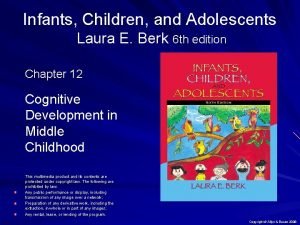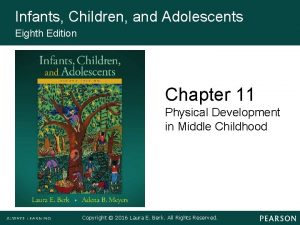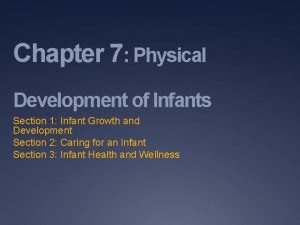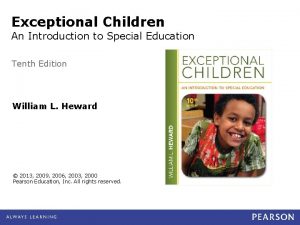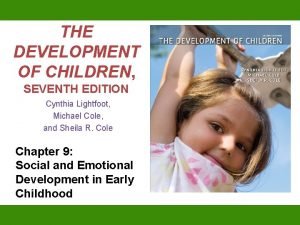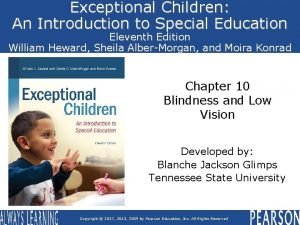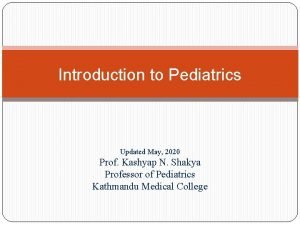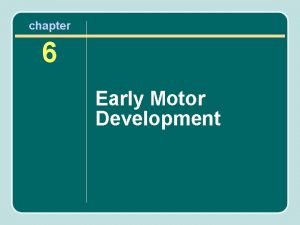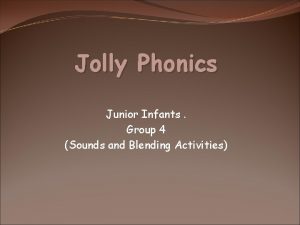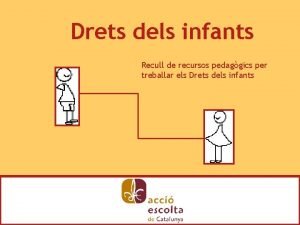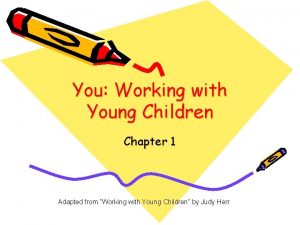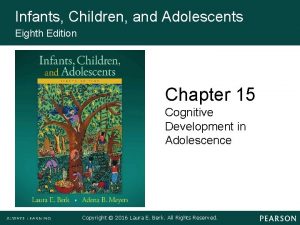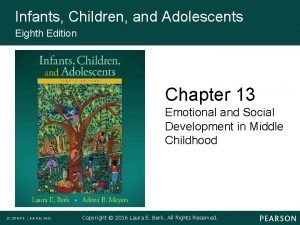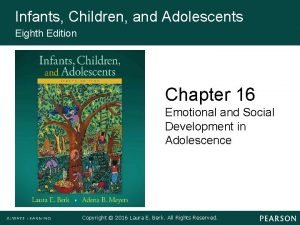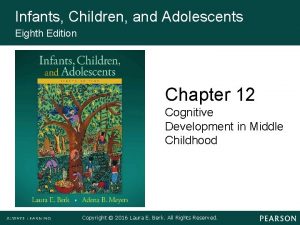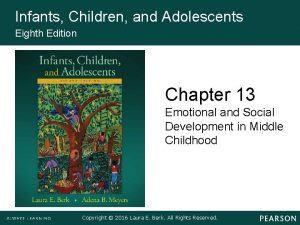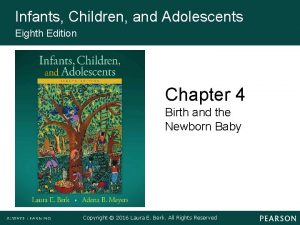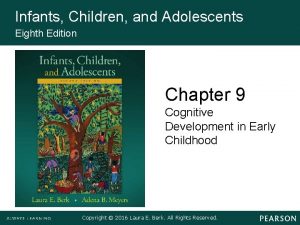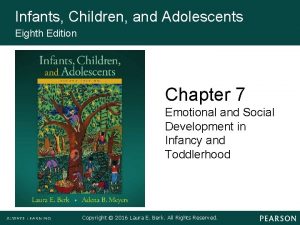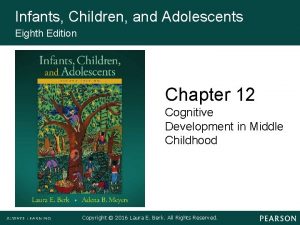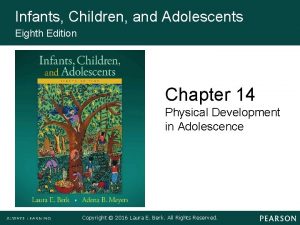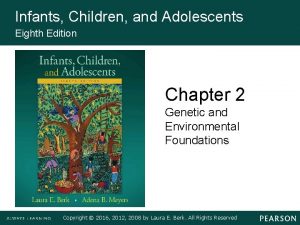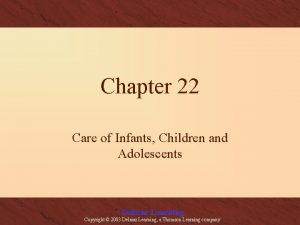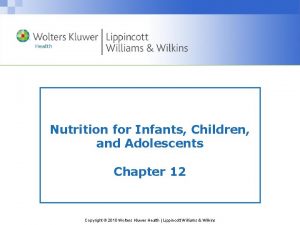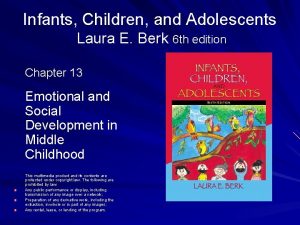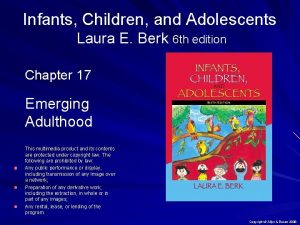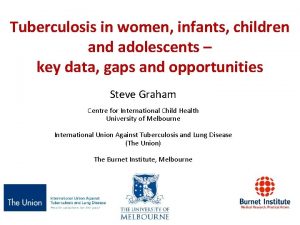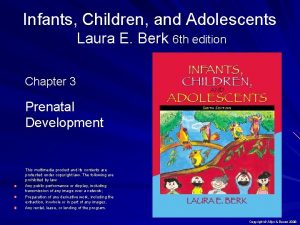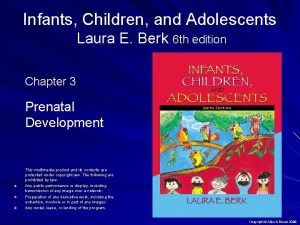Infants Children and Adolescents Eighth Edition Chapter 14














































- Slides: 46

Infants, Children, and Adolescents Eighth Edition Chapter 14 Physical Development in Adolescence Copyright © 2016 Laura E. Berk. All Rights Reserved.

Learning Objectives (1 of 3) • • • 14. 1 How have conceptions of adolescence changed over the past century? 14. 2 Describe body growth, motor performance, and sexual maturation during puberty. 14. 3 What factors influence the timing of puberty? 14. 4 Describe brain development and changes in the organization of sleep and wakefulness during adolescence. 14. 5 Explain adolescents’ reactions to the physical changes of puberty. Copyright © 2016 Laura E. Berk. All Rights Reserved.

Learning Objectives (2 of 3) • • • 14. 6 Describe the impact of pubertal timing on adolescent adjustment, noting sex differences. 14. 7 Describe nutritional needs, and cite factors related to eating disorders in adolescence. 14. 8 Cite common unintentional injuries in adolescence. 14. 9 Discuss social and cultural influences on adolescent sexual attitudes and behavior. 14. 10 Describe factors involved in the development of homosexuality. Copyright © 2016 Laura E. Berk. All Rights Reserved.

Learning Objectives (3 of 3) • • 14. 11 Discuss factors related to sexually transmitted infections and teenage pregnancy and parenthood. 14. 12 What personal and social factors are related to adolescent substance use and abuse? Copyright © 2016 Laura E. Berk. All Rights Reserved.

Conceptions of Adolescence • Biological perspective: – Puberty: period of storm and stress – Freud’s genital stage: reawakening of sexual impulses • Social perspective: – Role of social and cultural influences – Wide variability in adolescent adjustment • Balanced point of view: – Biological, psychological, and social influences – Cultural variation in length and demands of adolescence Copyright © 2016 Laura E. Berk. All Rights Reserved.

Phases of Adolescence Early Middle Late 11– 12 to 14 years 14 to 16 years 16 to 18 years Copyright © 2016 Laura E. Berk. All Rights Reserved. Rapid pubertal change Pubertal changes nearly complete Full adult appearance, assumption of adult roles

Hormonal Changes in Puberty • Release of growth hormone (GH) and thyroxine • Adrenarche: release of adrenal androgens • Estrogens – contribute to girls’ height spurt, development of female sex characteristics, regulation of menstrual cycle. – combine with androgens to stimulate gains in bone density. • Testosterone – is released by boys’ maturing testes. – leads to muscle growth, body and facial hair, other male sex characteristics; also contribute to gains in body size. Copyright © 2016 Laura E. Berk. All Rights Reserved.

Hormonal Influences on the Body at Puberty Figure 14. 1 Copyright © 2016 Laura E. Berk. All Rights Reserved.

Sex Differences in Body Growth in Adolescence Growth spurt Proportions Muscle–fat makeup Boys Girls Starts age 12½ Starts age 10 Shoulders broaden Hips broaden Longer legs Gain more muscle Gain more fat Heart, lung capacity increase Copyright © 2016 Laura E. Berk. All Rights Reserved.

Motor Development and Physical Activity • Improvement in gross-motor development with puberty: – Girls: slow, gradual gains – Boys: dramatic spurt in strength, speed, endurance • Boys’ use of performance-enhancing drugs: creatine, anabolic steroids, androstenedione • Decline in physical education and daily freetime physical activity with age Copyright © 2016 Laura E. Berk. All Rights Reserved.

Decline in Regular Free-Time Daily Physical Activity in Adolescence Figure 14. 3 (Based on Wall et al. , 2011. ) Copyright © 2016 Laura E. Berk. All Rights Reserved.

Sexual Maturation • Primary sexual characteristics: – Maturation of reproductive organs – Girls: menarche – Boys: spermarche • Secondary sexual characteristics: – – Girls: breasts Boys: facial hair, voice change Both sexes: underarm, pubic hair Other visible parts of the body that signal sexual maturity Copyright © 2016 Laura E. Berk. All Rights Reserved.

Individual Differences in Pubertal Growth Timing of pubertal changes is influenced by • heredity. • nutrition and exercise. • geographical location. • SES and ethnic group. • early family experiences. • secular trend toward earlier pubertal timing. Copyright © 2016 Laura E. Berk. All Rights Reserved.

Secular Trend in Age at Menarche Figure 14. 4 (From K. Sørensen et al. , 2012. “Recent Secular Trends in Pubertal Timing: Implications for Evaluation and Diagnosis of Precocious Puberty, ” Hormone Research in Pædiatrics, 77, p. 139. Copyright © 2012 Karger Publishers, Basel, Switzerland. Reprinted by permission. ) Copyright © 2016 Laura E. Berk. All Rights Reserved.

Brain Development in Adolescence • White matter increases, gray matter declines: – Pruning of unused synapses continues. – Myelination accelerates, strengthening connections among brain regions. – Prefrontal cortex becomes more effective “executive. ” • Neurons become more sensitive to excitatory neurotransmitters. • Changes in emotional/social network outpace development of prefrontal cognitive-control network. Copyright © 2016 Laura E. Berk. All Rights Reserved.

Sleep Habits in Adolescence • Adolescents need almost as much sleep as they did in middle childhood: about 9 hours. • Teenagers go to bed later because of – biological changes. – evening social activities, use of screen media. • Sleep deprivation – affects performance on cognitive tasks. – may lead to anxiety and depressed mood. – is associated with high-risk behaviors. Copyright © 2016 Laura E. Berk. All Rights Reserved.

Reactions to Pubertal Changes • Pubertal events affect self-image, mood, interaction with parents and peers. • Girls’ responses to menarche depend on – prior knowledge and family support. – cultural attitudes toward puberty and sexuality. • Tribal and village societies may celebrate puberty with initiation ceremony. • Western adolescents – have no widely accepted marker of maturity. – gain partial adult status at many different ages. Copyright © 2016 Laura E. Berk. All Rights Reserved.

Emotional and Social Responses to Puberty • Adolescent moodiness – is modestly linked to higher hormone levels. – is linked to negative life events. • Moods are less stable in younger than older adolescents. • Parent–child relationships: – Puberty is linked to rise in intensity of parent–child conflict. – Psychological distancing may be modern substitute for departure of the young from the family group. • Both generations benefit from warm family bonds throughout lifespan. Copyright © 2016 Laura E. Berk. All Rights Reserved.

Consequences of Pubertal Timing Boys Earlymaturing Latematuring • • • Girls • Unpopular, withdrawn • Low confidence, negative body image • More involved in deviant behavior • Unpopular • Popular • Transient emotional • Sociable, lively difficulties until they catch • Positive body image up physically with peers Popular Confident, independent Positive body image Psychological distress Problem behaviors Copyright © 2016 Laura E. Berk. All Rights Reserved.

Reactions to Timing of Puberty: Role of Physical Attractiveness • Body image: – Strong predictor of self-esteem for both sexes – Cultural ideal of thin, long-legged female and tall, muscular male body • Fitting in with peers: – Preference for peers who are similar in physical maturity – Risks for early maturers in economically disadvantaged neighborhoods • Long-term consequences: – Greatest risks for early-maturing girls – Unfavorable peer pressures, adjustment problems Copyright © 2016 Laura E. Berk. All Rights Reserved.

Nutrition in Adolescence • Dramatic rise in nutritional requirements • Poor food choices in adolescence: – Skipping breakfast – Eating on the run – Consuming empty calories • Common deficiencies: iron, calcium, vitamins • Risks associated with special diets Copyright © 2016 Laura E. Berk. All Rights Reserved.

Eating Disorders: Anorexia Nervosa • Anorexia nervosa affects about 1% of North American and Western European teenage girls: – Boys account for 10– 15% of cases. – Incidence has increased sharply in past half-century. • Individual, family, and cultural factors contribute: – Abnormalities in brain neurotransmitters – Parent–adolescent interactions related to autonomy – Societal image of “thin is beautiful” • Treatment is difficult: – Most successful combines family therapy and medication. – Less than 50% recover fully. Copyright © 2016 Laura E. Berk. All Rights Reserved.

Eating Disorders: Bulimia Nervosa and Binge-Eating Disorder • Bulimia nervosa affects 2– 4% of teenage girls: – Gay and bisexual boys are also vulnerable. – Most adolescents with bulimia lack self-control in many areas. – Feelings of guilt and depression are typical. • Binge-eating disorder affects 2– 3% of teenage girls and nearly 1 percent of boys – Equally prevalent among U. S. ethnic groups – Leads to weight gain and obesity • Treatment includes – support groups. – nutrition education and training in changing eating habits. – anti-anxiety, antidepressant, and appetite-control medication. Copyright © 2016 Laura E. Berk. All Rights Reserved.

Injuries During Adolescence • Automobile accidents are leading killer of U. S. adolescents: – Accidents result from high speed, alcohol use, not wearing seat belts, using mobile devices. – Graduated licensing laws have led to decline in fatalities. • Firearms cause majority of other fatal injuries, especially in poverty-stricken inner-city neighborhoods. • Sports-related injuries are common: – Concussions are of particular concern, especially in football. – Safest athletic activities during adolescence are limitedcontact team sports. Copyright © 2016 Laura E. Berk. All Rights Reserved.

Firearm Death Rates Among 15 - to 19 -Year-Olds Figure 14. 6 (Based on Canadian Paediatric Society, 2005; Centers for Disease Control and Prevention, 2014 d; Fingerhut & Christoffel, 2002. ) Copyright © 2016 Laura E. Berk. All Rights Reserved.

Impact of Culture on Sexual Activity • Sexual attitudes in North America are relatively restrictive. • Parents provide limited information. • Children learn about sex from friends, books, magazines, movies, TV, Internet: – The Internet is an especially hazardous “sex educator. ” – In one study, 42% of 10 - to 17 -year-olds had viewed pornographic websites in past 12 months. – Of these, 66% said they encountered the images accidentally. Copyright © 2016 Laura E. Berk. All Rights Reserved.

Parents and Teenagers (Don’t) Talk About Sex • Parent–child conversations about sex and contraception reduce sexual risk taking. • When parents dominate discussion, teenagers tend to withdraw. • Parents can communicate successfully with adolescents about sexual issues when they – – – foster open communication. use correct terms for body parts. use effective discussion techniques. reflect before speaking. keep the conversation going. Copyright © 2016 Laura E. Berk. All Rights Reserved.

Adolescent Sexual Attitudes and Behavior • Sexual attitudes of U. S. adolescents and adults have become more liberal in past half-century. • Recently, adolescents have moved slightly toward more conservative beliefs. • Substantial percentage of teenagers are sexually active by ninth grade. • Mutually consensual sexual activity in a stable, caring relationship can be a positive, satisfying experience for older adolescents. • Casual sex leads to guilt and depression. Copyright © 2016 Laura E. Berk. All Rights Reserved.

Sexual Activity Among U. S. Adolescents Figure 14. 7 (Based on Kann et al. , 2014. ) Copyright © 2016 Laura E. Berk. All Rights Reserved.

Characteristics of Adolescents Who Engage in Early Sexual Activity Personal Family Peer Educational • • • Early pubertal timing Tendency to violate norms Little or no religious involvement Single-parent or stepfamily homes Large family size Weak parental monitoring Disrupted parent–child communication Sexually active friends and older siblings Poor school performance Low educational aspirations Copyright © 2016 Laura E. Berk. All Rights Reserved.

Adolescent Contraceptive Use • Adolescent contraceptive use has increased in recent years. • However, about 18% of sexually active U. S. teens do not use contraception consistently. • Reasons for not using contraception include – difficulties with planning and self-regulation. – lack of communication with parents or medical personnel. – lack of realistic expectations about impact of early parenthood. Copyright © 2016 Laura E. Berk. All Rights Reserved.

Contraceptive Use by Sexually Active U. S. Adolescents Figure 14. 8 (Based on Centers for Disease Control and Prevention, 2014 i; Kann et al. , 2014. ) Copyright © 2016 Laura E. Berk. All Rights Reserved.

Sexual Orientation • About 5% of U. S. high school students identify as lesbian, gay, or bisexual. • Another 2– 3% are unsure of their sexual orientation. • An unknown number experience same-sex attraction but have not come out to friends or family. • Genetic and prenatal biological influences appear to be largely responsible for homosexuality. • Origins of bisexuality are not yet known. • Stereotypes and misconceptions about homosexuality and bisexuality continue to be widespread. Copyright © 2016 Laura E. Berk. All Rights Reserved.

Sequence of Coming Out • Feeling different: – Ages 6– 12 – Sexual questioning by age 10 • Confusion: – Boys: Aware they are gay around ages 10– 15 – Girls: Aware they are lesbian around ages 13– 18 • Self-acceptance: – By end of adolescence – Promoted by parental understanding Copyright © 2016 Laura E. Berk. All Rights Reserved.

Sexually Transmitted Infections (STIs) • Highest rates of STIs are seen in 15 - to 24 -year-olds. • HIV/AIDS is by far the most serious STI. • Human papillomavirus (HPV): – Most common STI – Vaccine available for females ages 11– 26 • Other common STIs: – – Chlamydia Gonorrhea Herpes simplex 2 (genital herpes) Trichomoniasis Copyright © 2016 Laura E. Berk. All Rights Reserved.

Preventing Sexually Transmitted Infections • Know your partner well. • Maintain mutual faithfulness. • Do not use drugs. • Always use a latex condom when having sex with a nonmarital partner. • Do not have sex with a person you know has an STI. • If you get an STI, inform all recent sexual partners. • Get vaccinated to protect against some forms of HPV. Copyright © 2016 Laura E. Berk. All Rights Reserved.

Adolescent Pregnancy • About 625, 000 U. S. adolescent girls became pregnant in most recently reported year: – Almost 11, 000 were younger than 15. – U. S. teen pregnancy rate is higher than in most other industrialized countries. • Number of U. S. teenage births is lower than 50 years ago: – About one-fourth of teen pregnancies end in abortion. – U. S. teenage birth rate is still up to five times higher than in many other developed nations. Copyright © 2016 Laura E. Berk. All Rights Reserved.

Adolescent Pregnancy in Industrialized Nations Figure 14. 9 (Based on World Bank, 2014. ) Copyright © 2016 Laura E. Berk. All Rights Reserved.

Correlates and Consequences of Adolescent Parenthood • More likely to be poor than agemates who postpone parenthood • Less likely to finish high school, marry, secure employment • Prenatal/birth complications resulting from inadequate diets, smoking, alcohol/drug use, lack of prenatal care • Tendency to pass on personal attributes and to create unfavorable child-rearing conditions Copyright © 2016 Laura E. Berk. All Rights Reserved.

Intergenerational Continuity in Adolescent Parenthood • Mothers’ age at first childbirth predicts age at which their children become parents. • Adolescent parenthood is linked to transfer of unfavorable conditions and characteristics to the next generation: – Home environmental quality and parenting skills – Intelligence and education – Father absence Copyright © 2016 Laura E. Berk. All Rights Reserved.

Preventing Teen Pregnancy Key elements of effective sex education programs: • They teach techniques for handling sexual situations, including refusal skills and communication skills. • They deliver clear, accurate messages appropriate to adolescents’ culture and experiences. • They last long enough to have an impact. • They provide specific information about contraceptives and ready access to them. Copyright © 2016 Laura E. Berk. All Rights Reserved.

Intervening with Adolescent Parents • Young parents need – – – health care. encouragement to stay in school. job training. instruction in parenting and life-management skills. high-quality, affordable child care. • Schools that provide these services – reduce incidence of low-birth-weight babies. – increase educational success. – prevent additional childbearing. • Programs focusing on teenage fathers promote financial and emotional commitment to their children. Copyright © 2016 Laura E. Berk. All Rights Reserved.

Adolescents’ Substance Use and Abuse • Teenage alcohol and drug use: – Pervasive in industrialized nations – Substantial decline since mid-1990 s – Rise in marijuana use since late 2000 s • Varying patterns: – Minimal experimenters are typically psychologically healthy. – A minority of teenagers move from use to abuse. • Correlates and consequences: – Impulsive, disruptive, hostile style is evident in early childhood. – Environmental factors include low SES, family mental health problems. – Serious adjustment problems may include chronic anxiety, depression, antisocial behavior. Copyright © 2016 Laura E. Berk. All Rights Reserved.

Tenth-Grade Substance Use: United States and Europe Figure 14. 10 (Based on ESPAD, 2013; Johnston et al. , 2014. ) Copyright © 2016 Laura E. Berk. All Rights Reserved.

Effective Prevention and Treatment Effective school and community programs • promote effective parenting, including monitoring of activities. • teach skills for resisting peer pressure. • reduce social acceptability of taking drugs by emphasizing health and safety risks. • get students to commit to not using drugs. • provide appealing substitute activities. Copyright © 2016 Laura E. Berk. All Rights Reserved.

Readers may view, browse, and/or download material for temporary copying purposes only, provided these uses are for noncommercial personal purposes. Except as provided by law, this material may not be further reproduced, distributed, transmitted, modified, adapted, performed, displayed, published, or sold in whole or in part, without prior written permission from the publisher. Copyright © 2016 Laura E. Berk. All Rights Reserved.
 Infants, children and adolescents 8th edition
Infants, children and adolescents 8th edition Lara berk
Lara berk Gains in perspective taking permit the transition to
Gains in perspective taking permit the transition to Infants and children 8th edition
Infants and children 8th edition Psychology eighth edition david g myers
Psychology eighth edition david g myers David g myers psychology 8th edition
David g myers psychology 8th edition Operations management eighth edition
Operations management eighth edition The fifth, sixth, seventh, and eighth amendments protect *
The fifth, sixth, seventh, and eighth amendments protect * The adolescent in society guided reading
The adolescent in society guided reading Intellectual development of infants chapter 9
Intellectual development of infants chapter 9 Chapter 7 physical development of infants
Chapter 7 physical development of infants Anagram of eighth
Anagram of eighth Inner planets matching
Inner planets matching Nearest quarter inch
Nearest quarter inch What is the eighth commandment catholic
What is the eighth commandment catholic Taj mahal 8th wonder of the world
Taj mahal 8th wonder of the world Three quarter partial veneer crown
Three quarter partial veneer crown Eighth amendment excessive bail
Eighth amendment excessive bail Eighth letter of the alphabet
Eighth letter of the alphabet Criminal justice lesson
Criminal justice lesson What's the 5th amendment
What's the 5th amendment Exceptional children 10th edition
Exceptional children 10th edition The development of children 7th edition
The development of children 7th edition The development of children 7th edition
The development of children 7th edition Exceptional children an introduction to special education
Exceptional children an introduction to special education Exceptional children 10th edition
Exceptional children 10th edition Mis chapter 6
Mis chapter 6 Using mis (10th edition)
Using mis (10th edition) Creative curriculum for infants and toddlers
Creative curriculum for infants and toddlers Intercostal retractions in infants
Intercostal retractions in infants Infants age range
Infants age range Give me a dozen healthy infants well-formed
Give me a dozen healthy infants well-formed What are sentinel injuries
What are sentinel injuries Art ideas for senior infants
Art ideas for senior infants Infants display a wide range of emotional expressions
Infants display a wide range of emotional expressions Derotative righting
Derotative righting Length board for infants
Length board for infants Que son datos discretos y continuos
Que son datos discretos y continuos Jjjj song
Jjjj song Dinamiques per treballar els drets dels infants
Dinamiques per treballar els drets dels infants 5 year old tammy mistakenly believes
5 year old tammy mistakenly believes Working with young children chapter 1
Working with young children chapter 1 Kinds in development chap 1
Kinds in development chap 1 Chapter 1 learning about children
Chapter 1 learning about children Organizational behavior chapter 1
Organizational behavior chapter 1 Thermodynamic vs kinetic control
Thermodynamic vs kinetic control Beer johnston
Beer johnston

